Criminal Law: Defamation, Confidentiality, and Data Protection
VerifiedAdded on 2023/03/20
|8
|2248
|60
Essay
AI Summary
This essay provides a comprehensive overview of criminal law, with a specific focus on defamation, confidentiality, and data protection. It defines defamation, including digital defamation, and discusses relevant statistics from Australia, highlighting the prevalence of such cases. The essay explores the importance of good practices in confidentiality and information handling, including the roles and responsibilities of human service professionals. It outlines legal obligations, potential risks, and the advantages and disadvantages of recording client data. Several significant legal cases are examined, including those involving negligence and breaches of duty by various organizations. The essay further discusses the Freedom of Information Act, confidentiality of minors, legal professional privilege, and data protection legislations such as the Privacy Act 1988 (Cth) and the Defamation Act 2005. The role of whistleblowers and the treatment of online publications in defamation cases are also touched upon, offering a complete understanding of the interplay between law, ethics, and practice in the context of criminal justice.
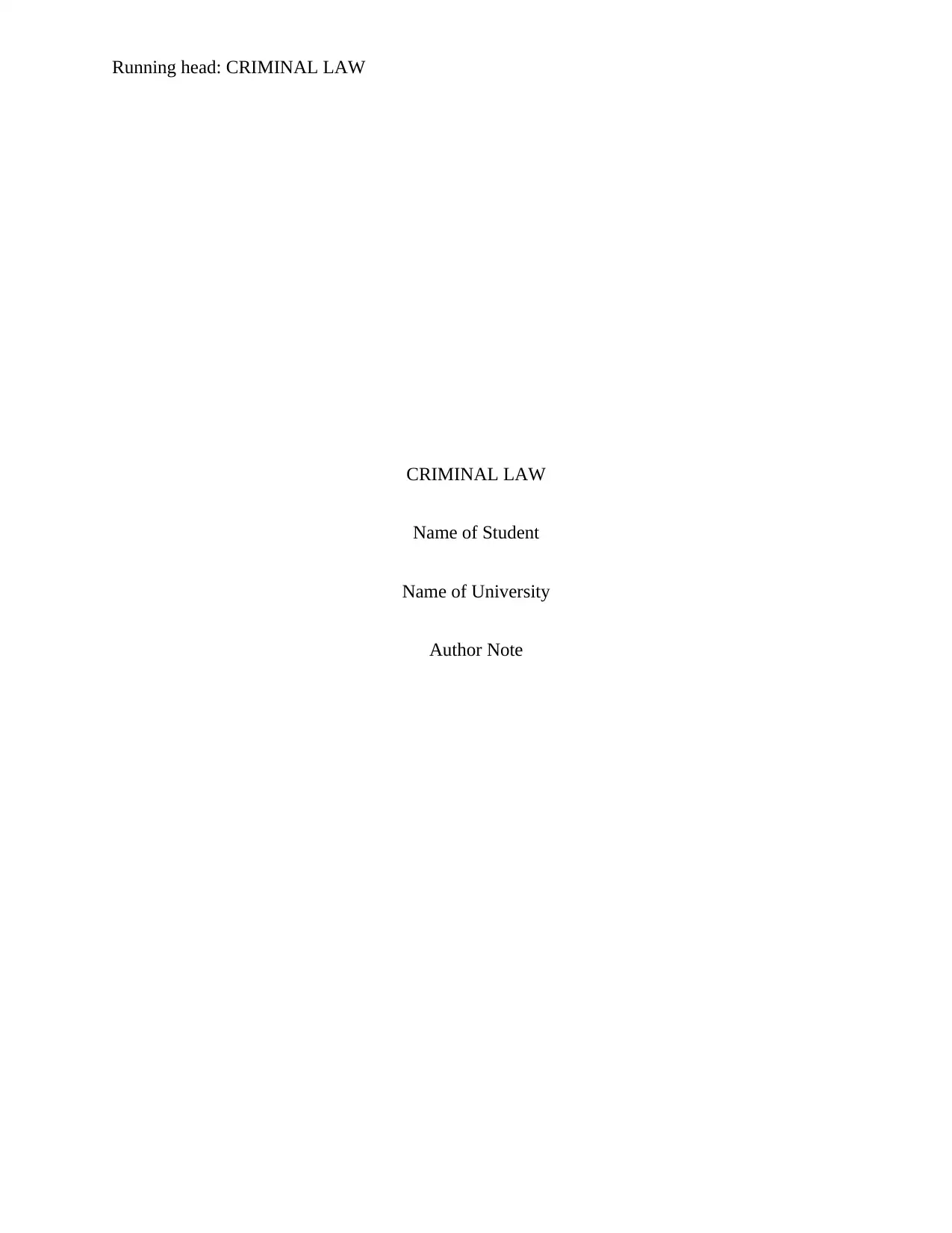
Running head: CRIMINAL LAW
CRIMINAL LAW
Name of Student
Name of University
Author Note
CRIMINAL LAW
Name of Student
Name of University
Author Note
Paraphrase This Document
Need a fresh take? Get an instant paraphrase of this document with our AI Paraphraser
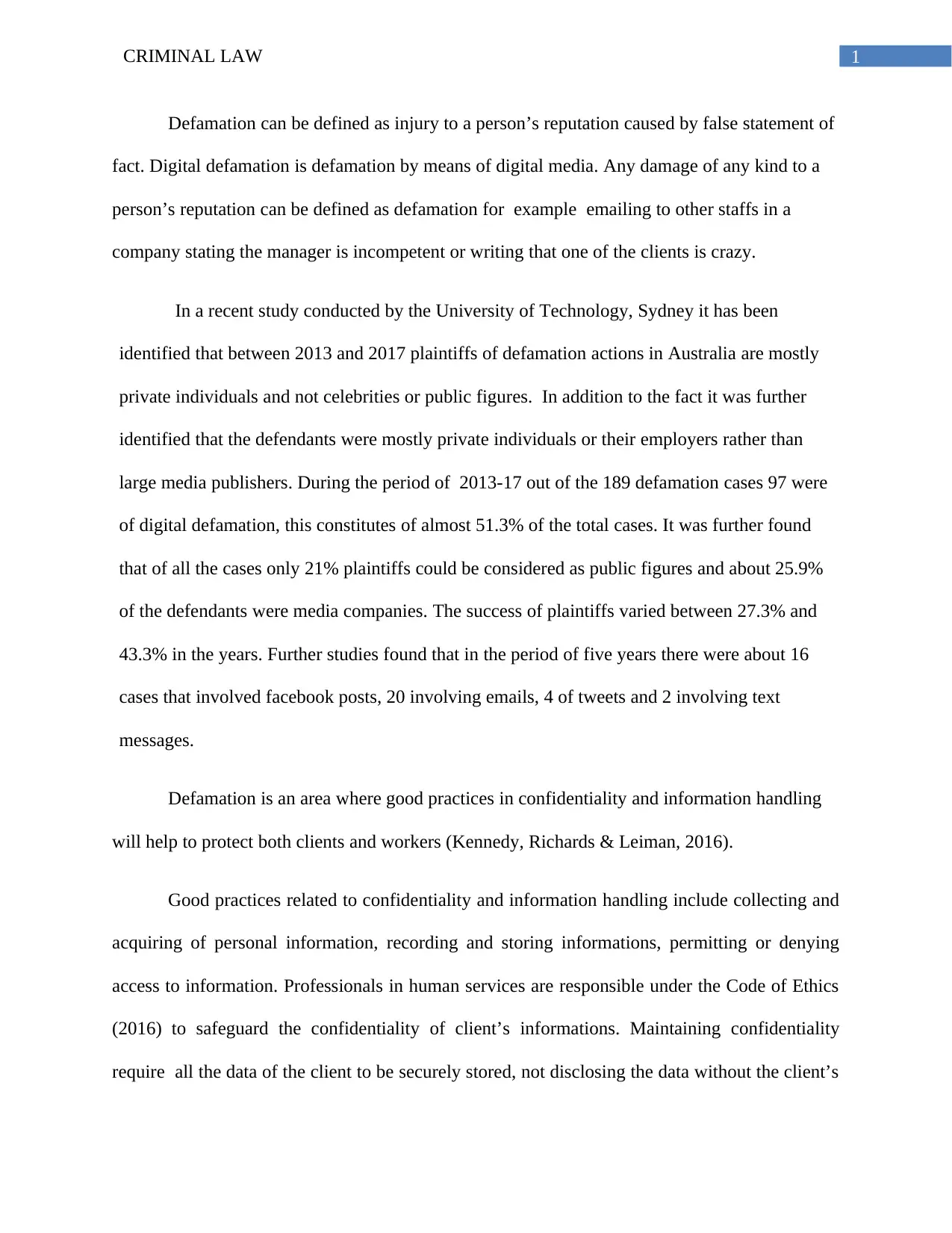
1CRIMINAL LAW
Defamation can be defined as injury to a person’s reputation caused by false statement of
fact. Digital defamation is defamation by means of digital media. Any damage of any kind to a
person’s reputation can be defined as defamation for example emailing to other staffs in a
company stating the manager is incompetent or writing that one of the clients is crazy.
In a recent study conducted by the University of Technology, Sydney it has been
identified that between 2013 and 2017 plaintiffs of defamation actions in Australia are mostly
private individuals and not celebrities or public figures. In addition to the fact it was further
identified that the defendants were mostly private individuals or their employers rather than
large media publishers. During the period of 2013-17 out of the 189 defamation cases 97 were
of digital defamation, this constitutes of almost 51.3% of the total cases. It was further found
that of all the cases only 21% plaintiffs could be considered as public figures and about 25.9%
of the defendants were media companies. The success of plaintiffs varied between 27.3% and
43.3% in the years. Further studies found that in the period of five years there were about 16
cases that involved facebook posts, 20 involving emails, 4 of tweets and 2 involving text
messages.
Defamation is an area where good practices in confidentiality and information handling
will help to protect both clients and workers (Kennedy, Richards & Leiman, 2016).
Good practices related to confidentiality and information handling include collecting and
acquiring of personal information, recording and storing informations, permitting or denying
access to information. Professionals in human services are responsible under the Code of Ethics
(2016) to safeguard the confidentiality of client’s informations. Maintaining confidentiality
require all the data of the client to be securely stored, not disclosing the data without the client’s
Defamation can be defined as injury to a person’s reputation caused by false statement of
fact. Digital defamation is defamation by means of digital media. Any damage of any kind to a
person’s reputation can be defined as defamation for example emailing to other staffs in a
company stating the manager is incompetent or writing that one of the clients is crazy.
In a recent study conducted by the University of Technology, Sydney it has been
identified that between 2013 and 2017 plaintiffs of defamation actions in Australia are mostly
private individuals and not celebrities or public figures. In addition to the fact it was further
identified that the defendants were mostly private individuals or their employers rather than
large media publishers. During the period of 2013-17 out of the 189 defamation cases 97 were
of digital defamation, this constitutes of almost 51.3% of the total cases. It was further found
that of all the cases only 21% plaintiffs could be considered as public figures and about 25.9%
of the defendants were media companies. The success of plaintiffs varied between 27.3% and
43.3% in the years. Further studies found that in the period of five years there were about 16
cases that involved facebook posts, 20 involving emails, 4 of tweets and 2 involving text
messages.
Defamation is an area where good practices in confidentiality and information handling
will help to protect both clients and workers (Kennedy, Richards & Leiman, 2016).
Good practices related to confidentiality and information handling include collecting and
acquiring of personal information, recording and storing informations, permitting or denying
access to information. Professionals in human services are responsible under the Code of Ethics
(2016) to safeguard the confidentiality of client’s informations. Maintaining confidentiality
require all the data of the client to be securely stored, not disclosing the data without the client’s
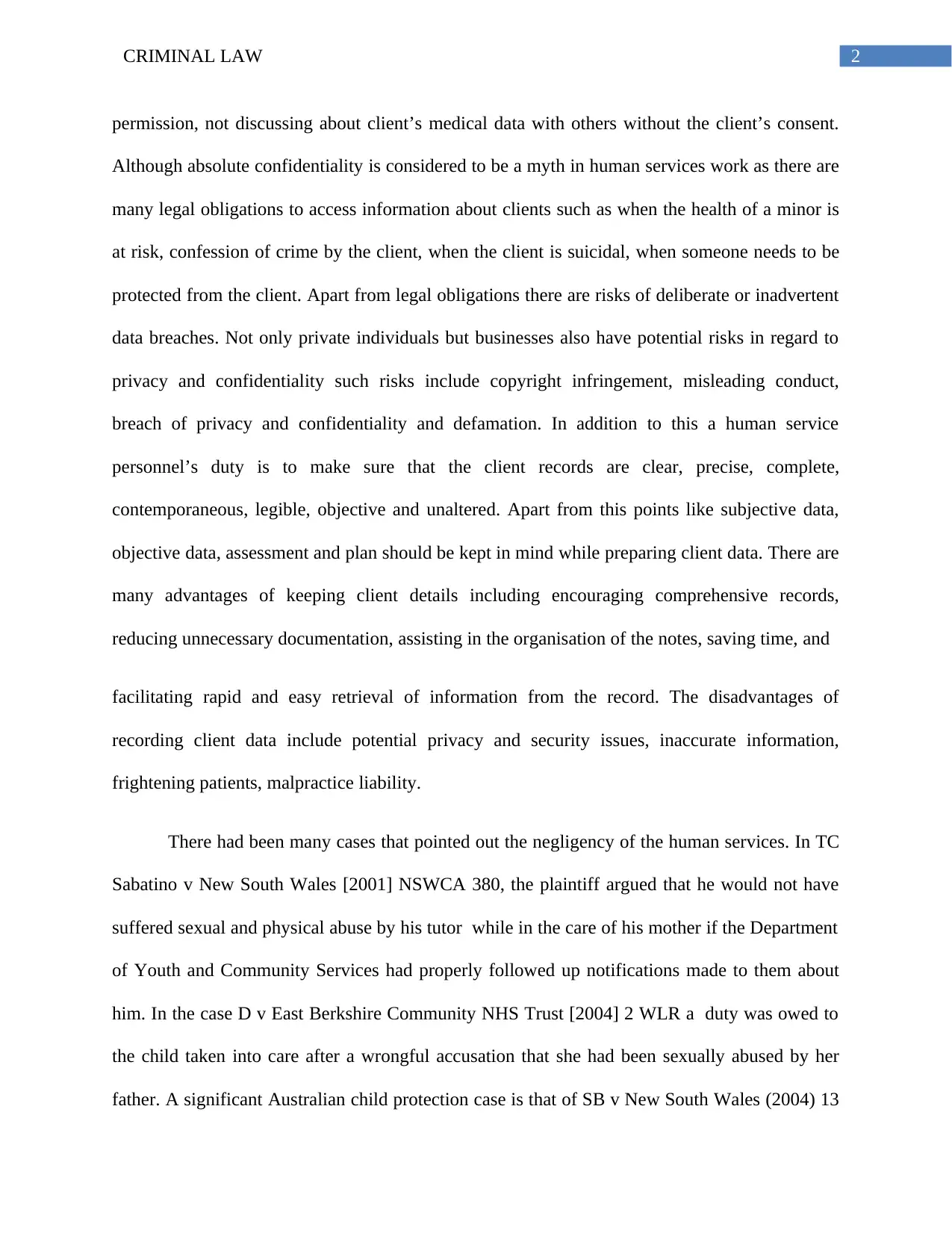
2CRIMINAL LAW
permission, not discussing about client’s medical data with others without the client’s consent.
Although absolute confidentiality is considered to be a myth in human services work as there are
many legal obligations to access information about clients such as when the health of a minor is
at risk, confession of crime by the client, when the client is suicidal, when someone needs to be
protected from the client. Apart from legal obligations there are risks of deliberate or inadvertent
data breaches. Not only private individuals but businesses also have potential risks in regard to
privacy and confidentiality such risks include copyright infringement, misleading conduct,
breach of privacy and confidentiality and defamation. In addition to this a human service
personnel’s duty is to make sure that the client records are clear, precise, complete,
contemporaneous, legible, objective and unaltered. Apart from this points like subjective data,
objective data, assessment and plan should be kept in mind while preparing client data. There are
many advantages of keeping client details including encouraging comprehensive records,
reducing unnecessary documentation, assisting in the organisation of the notes, saving time, and
facilitating rapid and easy retrieval of information from the record. The disadvantages of
recording client data include potential privacy and security issues, inaccurate information,
frightening patients, malpractice liability.
There had been many cases that pointed out the negligency of the human services. In TC
Sabatino v New South Wales [2001] NSWCA 380, the plaintiff argued that he would not have
suffered sexual and physical abuse by his tutor while in the care of his mother if the Department
of Youth and Community Services had properly followed up notifications made to them about
him. In the case D v East Berkshire Community NHS Trust [2004] 2 WLR a duty was owed to
the child taken into care after a wrongful accusation that she had been sexually abused by her
father. A significant Australian child protection case is that of SB v New South Wales (2004) 13
permission, not discussing about client’s medical data with others without the client’s consent.
Although absolute confidentiality is considered to be a myth in human services work as there are
many legal obligations to access information about clients such as when the health of a minor is
at risk, confession of crime by the client, when the client is suicidal, when someone needs to be
protected from the client. Apart from legal obligations there are risks of deliberate or inadvertent
data breaches. Not only private individuals but businesses also have potential risks in regard to
privacy and confidentiality such risks include copyright infringement, misleading conduct,
breach of privacy and confidentiality and defamation. In addition to this a human service
personnel’s duty is to make sure that the client records are clear, precise, complete,
contemporaneous, legible, objective and unaltered. Apart from this points like subjective data,
objective data, assessment and plan should be kept in mind while preparing client data. There are
many advantages of keeping client details including encouraging comprehensive records,
reducing unnecessary documentation, assisting in the organisation of the notes, saving time, and
facilitating rapid and easy retrieval of information from the record. The disadvantages of
recording client data include potential privacy and security issues, inaccurate information,
frightening patients, malpractice liability.
There had been many cases that pointed out the negligency of the human services. In TC
Sabatino v New South Wales [2001] NSWCA 380, the plaintiff argued that he would not have
suffered sexual and physical abuse by his tutor while in the care of his mother if the Department
of Youth and Community Services had properly followed up notifications made to them about
him. In the case D v East Berkshire Community NHS Trust [2004] 2 WLR a duty was owed to
the child taken into care after a wrongful accusation that she had been sexually abused by her
father. A significant Australian child protection case is that of SB v New South Wales (2004) 13
⊘ This is a preview!⊘
Do you want full access?
Subscribe today to unlock all pages.

Trusted by 1+ million students worldwide
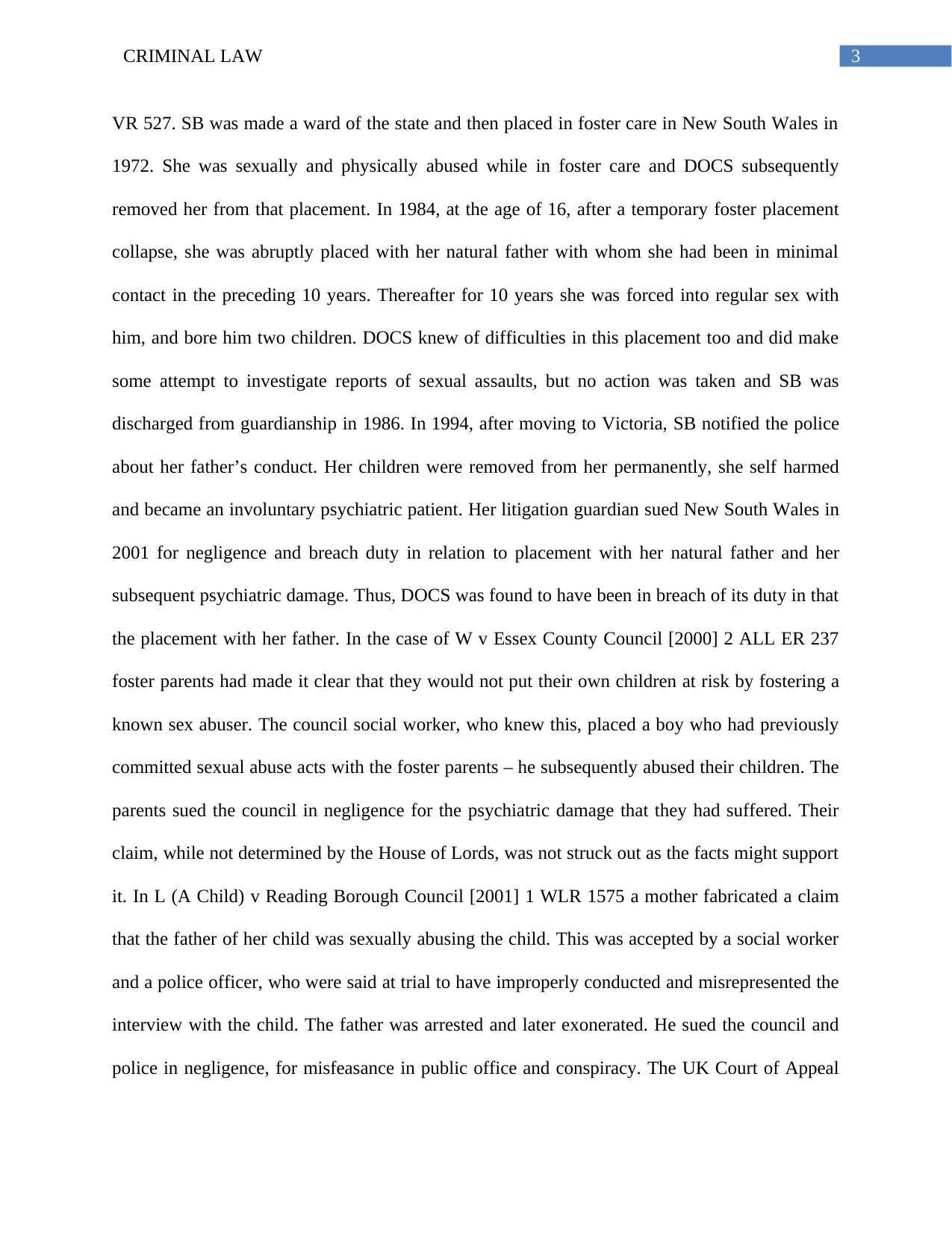
3CRIMINAL LAW
VR 527. SB was made a ward of the state and then placed in foster care in New South Wales in
1972. She was sexually and physically abused while in foster care and DOCS subsequently
removed her from that placement. In 1984, at the age of 16, after a temporary foster placement
collapse, she was abruptly placed with her natural father with whom she had been in minimal
contact in the preceding 10 years. Thereafter for 10 years she was forced into regular sex with
him, and bore him two children. DOCS knew of difficulties in this placement too and did make
some attempt to investigate reports of sexual assaults, but no action was taken and SB was
discharged from guardianship in 1986. In 1994, after moving to Victoria, SB notified the police
about her father’s conduct. Her children were removed from her permanently, she self harmed
and became an involuntary psychiatric patient. Her litigation guardian sued New South Wales in
2001 for negligence and breach duty in relation to placement with her natural father and her
subsequent psychiatric damage. Thus, DOCS was found to have been in breach of its duty in that
the placement with her father. In the case of W v Essex County Council [2000] 2 ALL ER 237
foster parents had made it clear that they would not put their own children at risk by fostering a
known sex abuser. The council social worker, who knew this, placed a boy who had previously
committed sexual abuse acts with the foster parents – he subsequently abused their children. The
parents sued the council in negligence for the psychiatric damage that they had suffered. Their
claim, while not determined by the House of Lords, was not struck out as the facts might support
it. In L (A Child) v Reading Borough Council [2001] 1 WLR 1575 a mother fabricated a claim
that the father of her child was sexually abusing the child. This was accepted by a social worker
and a police officer, who were said at trial to have improperly conducted and misrepresented the
interview with the child. The father was arrested and later exonerated. He sued the council and
police in negligence, for misfeasance in public office and conspiracy. The UK Court of Appeal
VR 527. SB was made a ward of the state and then placed in foster care in New South Wales in
1972. She was sexually and physically abused while in foster care and DOCS subsequently
removed her from that placement. In 1984, at the age of 16, after a temporary foster placement
collapse, she was abruptly placed with her natural father with whom she had been in minimal
contact in the preceding 10 years. Thereafter for 10 years she was forced into regular sex with
him, and bore him two children. DOCS knew of difficulties in this placement too and did make
some attempt to investigate reports of sexual assaults, but no action was taken and SB was
discharged from guardianship in 1986. In 1994, after moving to Victoria, SB notified the police
about her father’s conduct. Her children were removed from her permanently, she self harmed
and became an involuntary psychiatric patient. Her litigation guardian sued New South Wales in
2001 for negligence and breach duty in relation to placement with her natural father and her
subsequent psychiatric damage. Thus, DOCS was found to have been in breach of its duty in that
the placement with her father. In the case of W v Essex County Council [2000] 2 ALL ER 237
foster parents had made it clear that they would not put their own children at risk by fostering a
known sex abuser. The council social worker, who knew this, placed a boy who had previously
committed sexual abuse acts with the foster parents – he subsequently abused their children. The
parents sued the council in negligence for the psychiatric damage that they had suffered. Their
claim, while not determined by the House of Lords, was not struck out as the facts might support
it. In L (A Child) v Reading Borough Council [2001] 1 WLR 1575 a mother fabricated a claim
that the father of her child was sexually abusing the child. This was accepted by a social worker
and a police officer, who were said at trial to have improperly conducted and misrepresented the
interview with the child. The father was arrested and later exonerated. He sued the council and
police in negligence, for misfeasance in public office and conspiracy. The UK Court of Appeal
Paraphrase This Document
Need a fresh take? Get an instant paraphrase of this document with our AI Paraphraser
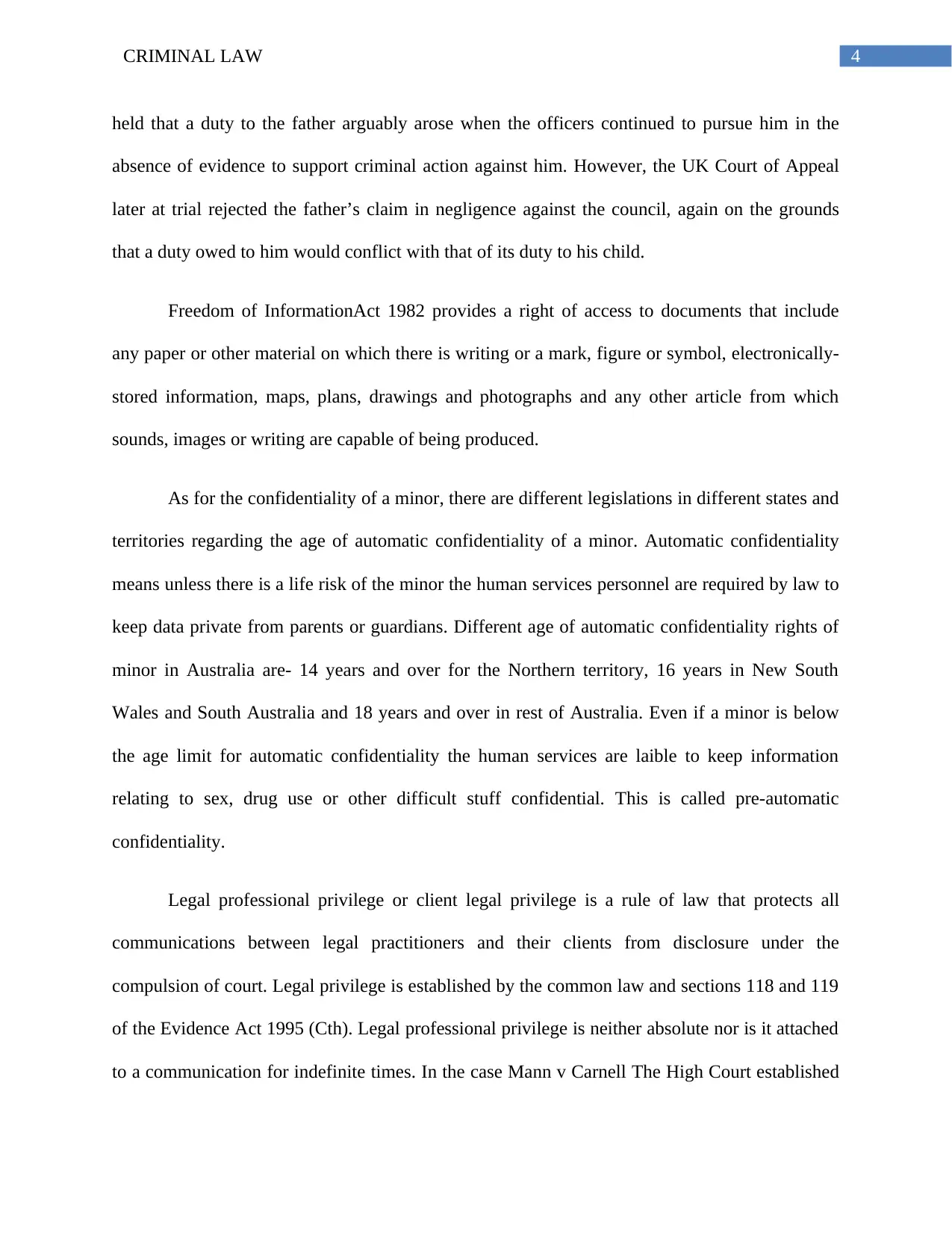
4CRIMINAL LAW
held that a duty to the father arguably arose when the officers continued to pursue him in the
absence of evidence to support criminal action against him. However, the UK Court of Appeal
later at trial rejected the father’s claim in negligence against the council, again on the grounds
that a duty owed to him would conflict with that of its duty to his child.
Freedom of InformationAct 1982 provides a right of access to documents that include
any paper or other material on which there is writing or a mark, figure or symbol, electronically-
stored information, maps, plans, drawings and photographs and any other article from which
sounds, images or writing are capable of being produced.
As for the confidentiality of a minor, there are different legislations in different states and
territories regarding the age of automatic confidentiality of a minor. Automatic confidentiality
means unless there is a life risk of the minor the human services personnel are required by law to
keep data private from parents or guardians. Different age of automatic confidentiality rights of
minor in Australia are- 14 years and over for the Northern territory, 16 years in New South
Wales and South Australia and 18 years and over in rest of Australia. Even if a minor is below
the age limit for automatic confidentiality the human services are laible to keep information
relating to sex, drug use or other difficult stuff confidential. This is called pre-automatic
confidentiality.
Legal professional privilege or client legal privilege is a rule of law that protects all
communications between legal practitioners and their clients from disclosure under the
compulsion of court. Legal privilege is established by the common law and sections 118 and 119
of the Evidence Act 1995 (Cth). Legal professional privilege is neither absolute nor is it attached
to a communication for indefinite times. In the case Mann v Carnell The High Court established
held that a duty to the father arguably arose when the officers continued to pursue him in the
absence of evidence to support criminal action against him. However, the UK Court of Appeal
later at trial rejected the father’s claim in negligence against the council, again on the grounds
that a duty owed to him would conflict with that of its duty to his child.
Freedom of InformationAct 1982 provides a right of access to documents that include
any paper or other material on which there is writing or a mark, figure or symbol, electronically-
stored information, maps, plans, drawings and photographs and any other article from which
sounds, images or writing are capable of being produced.
As for the confidentiality of a minor, there are different legislations in different states and
territories regarding the age of automatic confidentiality of a minor. Automatic confidentiality
means unless there is a life risk of the minor the human services personnel are required by law to
keep data private from parents or guardians. Different age of automatic confidentiality rights of
minor in Australia are- 14 years and over for the Northern territory, 16 years in New South
Wales and South Australia and 18 years and over in rest of Australia. Even if a minor is below
the age limit for automatic confidentiality the human services are laible to keep information
relating to sex, drug use or other difficult stuff confidential. This is called pre-automatic
confidentiality.
Legal professional privilege or client legal privilege is a rule of law that protects all
communications between legal practitioners and their clients from disclosure under the
compulsion of court. Legal privilege is established by the common law and sections 118 and 119
of the Evidence Act 1995 (Cth). Legal professional privilege is neither absolute nor is it attached
to a communication for indefinite times. In the case Mann v Carnell The High Court established
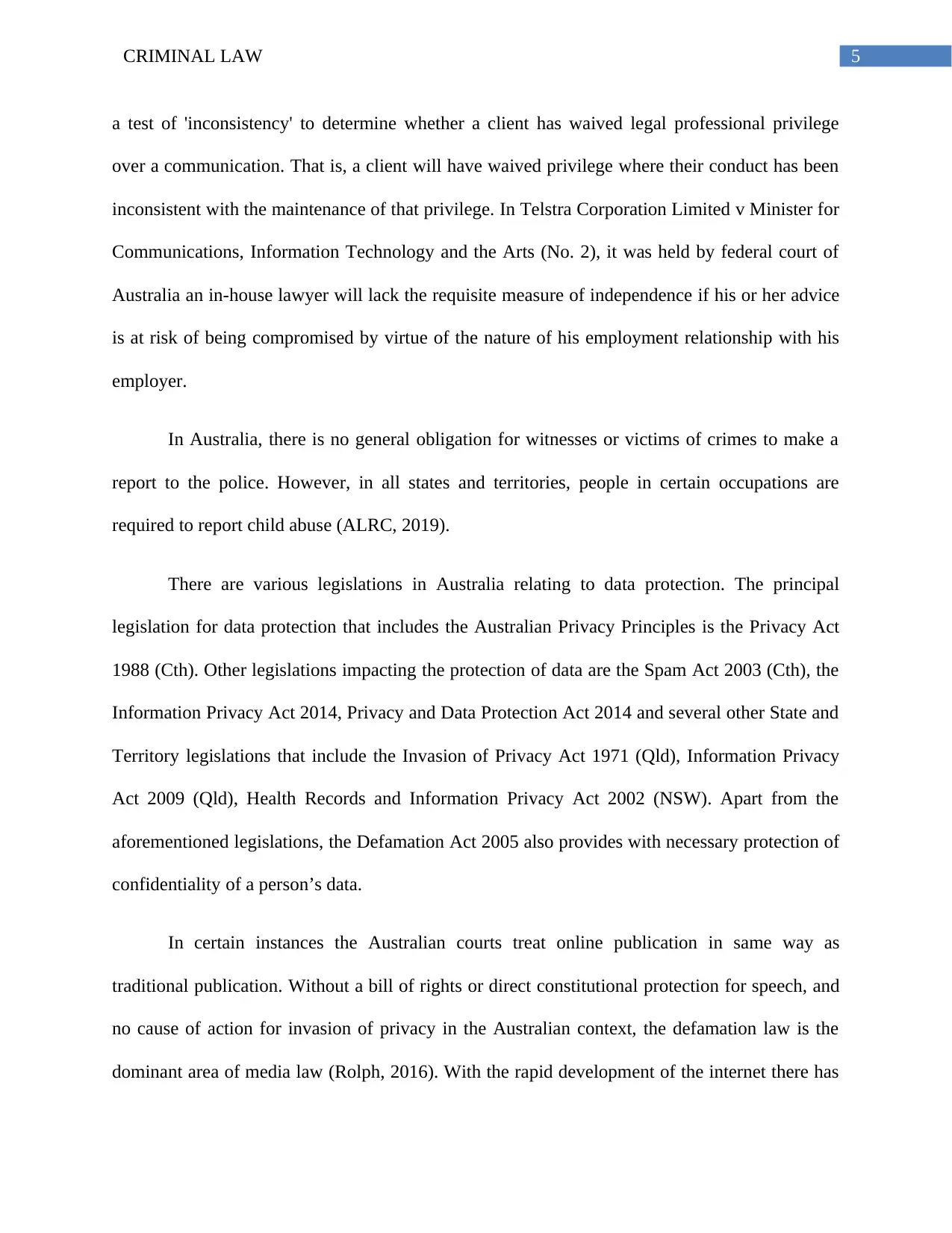
5CRIMINAL LAW
a test of 'inconsistency' to determine whether a client has waived legal professional privilege
over a communication. That is, a client will have waived privilege where their conduct has been
inconsistent with the maintenance of that privilege. In Telstra Corporation Limited v Minister for
Communications, Information Technology and the Arts (No. 2), it was held by federal court of
Australia an in-house lawyer will lack the requisite measure of independence if his or her advice
is at risk of being compromised by virtue of the nature of his employment relationship with his
employer.
In Australia, there is no general obligation for witnesses or victims of crimes to make a
report to the police. However, in all states and territories, people in certain occupations are
required to report child abuse (ALRC, 2019).
There are various legislations in Australia relating to data protection. The principal
legislation for data protection that includes the Australian Privacy Principles is the Privacy Act
1988 (Cth). Other legislations impacting the protection of data are the Spam Act 2003 (Cth), the
Information Privacy Act 2014, Privacy and Data Protection Act 2014 and several other State and
Territory legislations that include the Invasion of Privacy Act 1971 (Qld), Information Privacy
Act 2009 (Qld), Health Records and Information Privacy Act 2002 (NSW). Apart from the
aforementioned legislations, the Defamation Act 2005 also provides with necessary protection of
confidentiality of a person’s data.
In certain instances the Australian courts treat online publication in same way as
traditional publication. Without a bill of rights or direct constitutional protection for speech, and
no cause of action for invasion of privacy in the Australian context, the defamation law is the
dominant area of media law (Rolph, 2016). With the rapid development of the internet there has
a test of 'inconsistency' to determine whether a client has waived legal professional privilege
over a communication. That is, a client will have waived privilege where their conduct has been
inconsistent with the maintenance of that privilege. In Telstra Corporation Limited v Minister for
Communications, Information Technology and the Arts (No. 2), it was held by federal court of
Australia an in-house lawyer will lack the requisite measure of independence if his or her advice
is at risk of being compromised by virtue of the nature of his employment relationship with his
employer.
In Australia, there is no general obligation for witnesses or victims of crimes to make a
report to the police. However, in all states and territories, people in certain occupations are
required to report child abuse (ALRC, 2019).
There are various legislations in Australia relating to data protection. The principal
legislation for data protection that includes the Australian Privacy Principles is the Privacy Act
1988 (Cth). Other legislations impacting the protection of data are the Spam Act 2003 (Cth), the
Information Privacy Act 2014, Privacy and Data Protection Act 2014 and several other State and
Territory legislations that include the Invasion of Privacy Act 1971 (Qld), Information Privacy
Act 2009 (Qld), Health Records and Information Privacy Act 2002 (NSW). Apart from the
aforementioned legislations, the Defamation Act 2005 also provides with necessary protection of
confidentiality of a person’s data.
In certain instances the Australian courts treat online publication in same way as
traditional publication. Without a bill of rights or direct constitutional protection for speech, and
no cause of action for invasion of privacy in the Australian context, the defamation law is the
dominant area of media law (Rolph, 2016). With the rapid development of the internet there has
⊘ This is a preview!⊘
Do you want full access?
Subscribe today to unlock all pages.

Trusted by 1+ million students worldwide
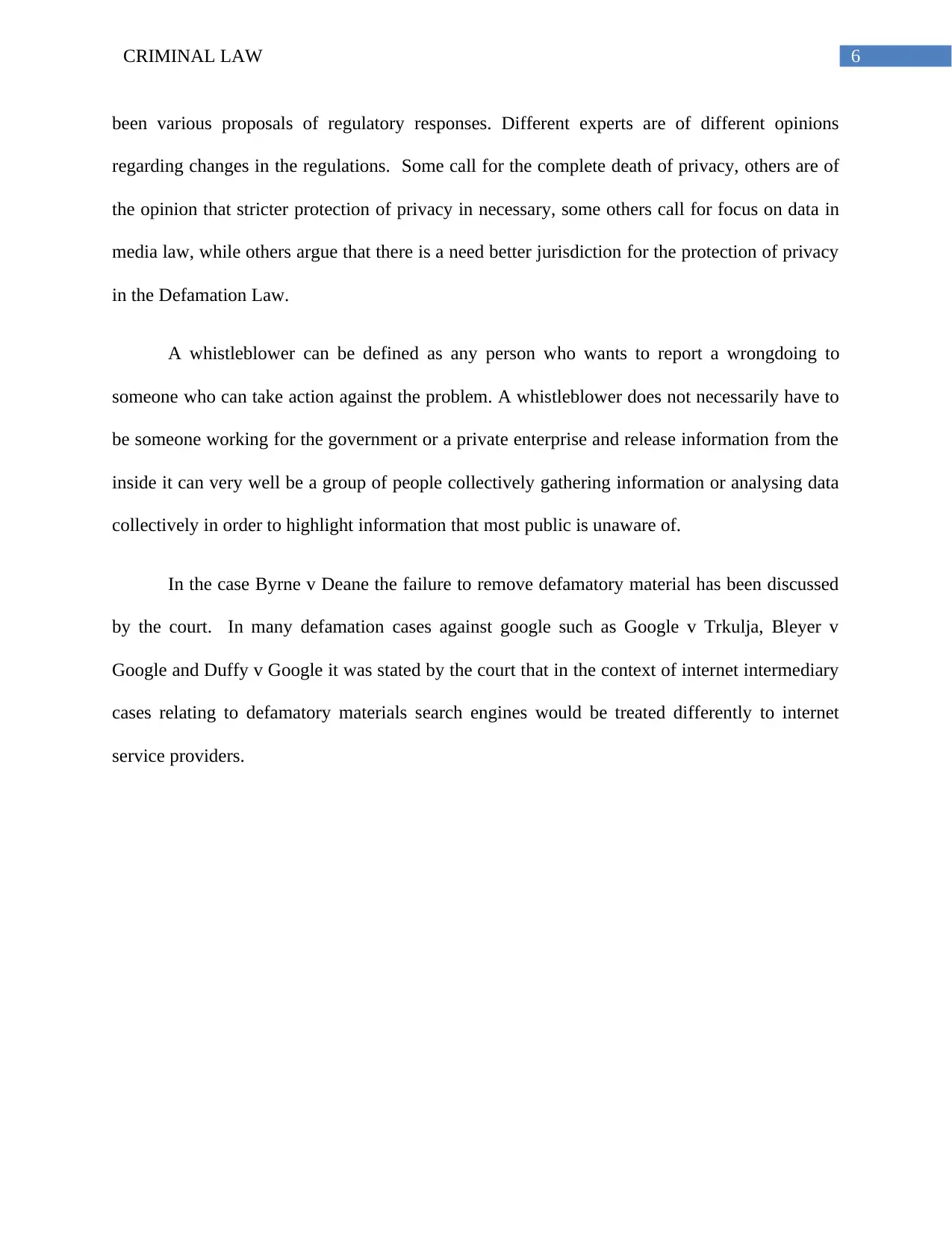
6CRIMINAL LAW
been various proposals of regulatory responses. Different experts are of different opinions
regarding changes in the regulations. Some call for the complete death of privacy, others are of
the opinion that stricter protection of privacy in necessary, some others call for focus on data in
media law, while others argue that there is a need better jurisdiction for the protection of privacy
in the Defamation Law.
A whistleblower can be defined as any person who wants to report a wrongdoing to
someone who can take action against the problem. A whistleblower does not necessarily have to
be someone working for the government or a private enterprise and release information from the
inside it can very well be a group of people collectively gathering information or analysing data
collectively in order to highlight information that most public is unaware of.
In the case Byrne v Deane the failure to remove defamatory material has been discussed
by the court. In many defamation cases against google such as Google v Trkulja, Bleyer v
Google and Duffy v Google it was stated by the court that in the context of internet intermediary
cases relating to defamatory materials search engines would be treated differently to internet
service providers.
been various proposals of regulatory responses. Different experts are of different opinions
regarding changes in the regulations. Some call for the complete death of privacy, others are of
the opinion that stricter protection of privacy in necessary, some others call for focus on data in
media law, while others argue that there is a need better jurisdiction for the protection of privacy
in the Defamation Law.
A whistleblower can be defined as any person who wants to report a wrongdoing to
someone who can take action against the problem. A whistleblower does not necessarily have to
be someone working for the government or a private enterprise and release information from the
inside it can very well be a group of people collectively gathering information or analysing data
collectively in order to highlight information that most public is unaware of.
In the case Byrne v Deane the failure to remove defamatory material has been discussed
by the court. In many defamation cases against google such as Google v Trkulja, Bleyer v
Google and Duffy v Google it was stated by the court that in the context of internet intermediary
cases relating to defamatory materials search engines would be treated differently to internet
service providers.
Paraphrase This Document
Need a fresh take? Get an instant paraphrase of this document with our AI Paraphraser
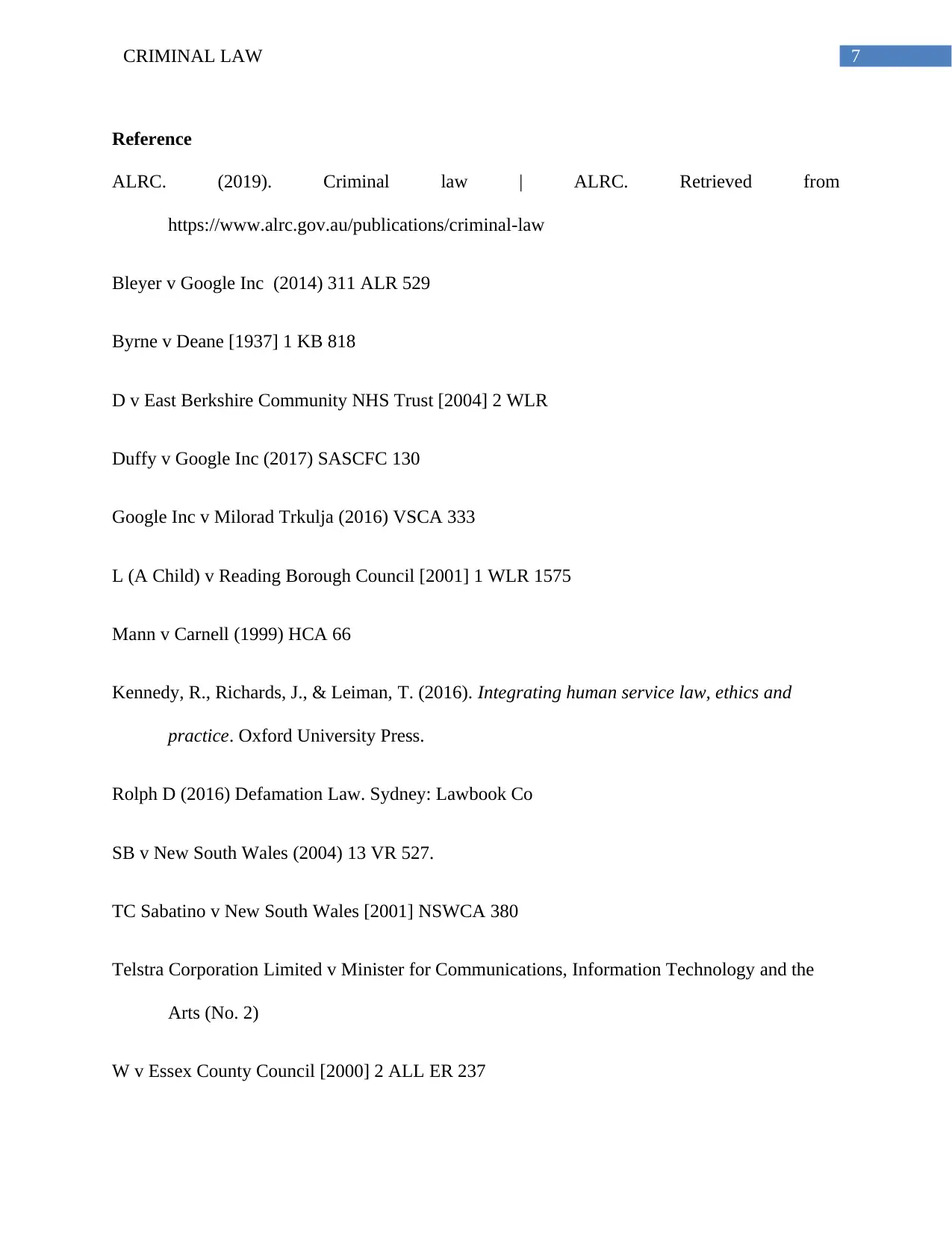
7CRIMINAL LAW
Reference
ALRC. (2019). Criminal law | ALRC. Retrieved from
https://www.alrc.gov.au/publications/criminal-law
Bleyer v Google Inc (2014) 311 ALR 529
Byrne v Deane [1937] 1 KB 818
D v East Berkshire Community NHS Trust [2004] 2 WLR
Duffy v Google Inc (2017) SASCFC 130
Google Inc v Milorad Trkulja (2016) VSCA 333
L (A Child) v Reading Borough Council [2001] 1 WLR 1575
Mann v Carnell (1999) HCA 66
Kennedy, R., Richards, J., & Leiman, T. (2016). Integrating human service law, ethics and
practice. Oxford University Press.
Rolph D (2016) Defamation Law. Sydney: Lawbook Co
SB v New South Wales (2004) 13 VR 527.
TC Sabatino v New South Wales [2001] NSWCA 380
Telstra Corporation Limited v Minister for Communications, Information Technology and the
Arts (No. 2)
W v Essex County Council [2000] 2 ALL ER 237
Reference
ALRC. (2019). Criminal law | ALRC. Retrieved from
https://www.alrc.gov.au/publications/criminal-law
Bleyer v Google Inc (2014) 311 ALR 529
Byrne v Deane [1937] 1 KB 818
D v East Berkshire Community NHS Trust [2004] 2 WLR
Duffy v Google Inc (2017) SASCFC 130
Google Inc v Milorad Trkulja (2016) VSCA 333
L (A Child) v Reading Borough Council [2001] 1 WLR 1575
Mann v Carnell (1999) HCA 66
Kennedy, R., Richards, J., & Leiman, T. (2016). Integrating human service law, ethics and
practice. Oxford University Press.
Rolph D (2016) Defamation Law. Sydney: Lawbook Co
SB v New South Wales (2004) 13 VR 527.
TC Sabatino v New South Wales [2001] NSWCA 380
Telstra Corporation Limited v Minister for Communications, Information Technology and the
Arts (No. 2)
W v Essex County Council [2000] 2 ALL ER 237
1 out of 8
Related Documents
Your All-in-One AI-Powered Toolkit for Academic Success.
+13062052269
info@desklib.com
Available 24*7 on WhatsApp / Email
![[object Object]](/_next/static/media/star-bottom.7253800d.svg)
Unlock your academic potential
Copyright © 2020–2025 A2Z Services. All Rights Reserved. Developed and managed by ZUCOL.





